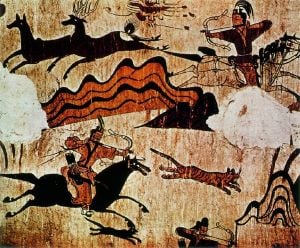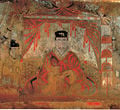Complex of Goguryeo Tombs
| Complex of Goguryeo Tombs | ||||||||
|---|---|---|---|---|---|---|---|---|
|
| Complex of Goguryeo Tombs | ||||||||
|---|---|---|---|---|---|---|---|---|
|
| Complex of Koguryo Tombs* | |
|---|---|
| UNESCO World Heritage Site | |

| |
| State Party | |
| Type | Cultural |
| Criteria | i, ii, iii, iv |
| Reference | 1091 |
| Region** | Asia-Pacific |
| Inscription history | |
| Inscription | 2004 (28th Session) |
| * Name as inscribed on World Heritage List. ** Region as classified by UNESCO. | |
The Complex of Goguryeo Tombs lies in North Korea. In July 2004, it became the first UNESCO World Heritage Site in the country. The site consists of sixty three individual tombs from the later Goguryeo kingdom, one of Three Kingdoms of Korea, located in the cities of P'yŏngyang and Namp'o.
History
Goguryeo was one of the strongest kingdoms in the north east of China and the Korean Peninsula between the 5th and 7th centuries AD. The kingdom was founded in the present day area of Northern Korea, Northeastern China, and part of Manchuria around 32 BC, and the capital was transferred to P'yŏngyang in AD 427.
Description
Anak Tomb No.3
Anak Tomb No.3 is a chamber tomb of Goguryeo located in Anak, South Hwanghae Province, North Korea. It is known for mural paintings and an epitaph. It is part of the Complex of Goguryeo Tombs.
It was discovered in 1949 with valuable treasures having been stolen, but murals were kept in good condition. The man and woman in wall paitings wear Chinese-style dresses and are considered the masters of the tomb. Its structure and murals are closer to those of Chinese tombs found in Liaoning than to those of Goguryeo.
Epitaph and its interpretation
The Anak Tomb No.3 is one of few Goguryeo tombs that have epitaphs so that their dates can be determined. Its seven-lined epitaph contains the date 357, the personal name Dong Shou (冬壽), his title, his birthplace and his age at death. Accordingly, scholars generally regard this site as the tomb of Dong Shou. Although North Korean scholars claim that it is the mausoleum of King Micheon or King Gogugwon, such theories are not considered seriously outside North Korea.
Dong Shou is identified as Tong Shou (佟壽), who is recorded in the Book of Jin and Zizhi Tongjian. Originated in the Liaodong Commandery, he served to Xianbei ruler Murong Huang of the Former Yan. By order of the emperor, Commander Tong Shou attacked Huang's brother and rival Murong Ren in Liaodong sometime around 331, but he surrendered to Ren after being severely defeated. In 336, however, Murong Ren was killed by Huang and Tong Shou fled to Goguryeo. He spent the rest of life in Goguryeo.
The epitaph reflects a complex situation in which Tong Shou, and Goguryeo, were put. It uses Yonghe (永和), the era name of the Eastern Jin Dynasty in Southern China although the era name had already been changed from Yonghe to Shengping in that year. He claimed various titles including "Minister of Lelang" and "Governor of Changli, Xuantu and Daifang." They are obviously nominal but indicates his leverage over Chinese in the Korean peninsula. It is not clear whether these titles were given by the Eastern Jin or just self-designation. Scholars associate one of his title "Minister of Lelang" with the title "Duke of Lelang", which was bestowed on King Gogugwon by Murong Jun of the Former Yan in 354. This means that the former traitor to the Former Yan became its rear vassal.
Although the Eastern Jin had no longer any control over northwestern Korea, there is much evidence that people there had affection for the Eastern Jin. Lelang and Daifang Commanderies were conquered by Goguryeo around 313 but it is unlikely that Goguryeo assumed full control over the former commanderies because its capital was still in far-north Wandu and Goguryeo had been defeated severely by the Former Yan in 342. The Chinese seem to have enjoyed a high degree of autonomy and have taken the lead of the Goguryeo culture until they were absorbed by the natives.[1]
- An3 woman.jpg
Many of the tombs, such as the Anak Tomb No. 3, have beautiful wall paintings. The tombs are almost all that remains from this culture. There are over 10,000 Goguryeo tombs overall, but only about ninety of those unearthed in China and Korea so far have wall paintings. The Complex of Goguryeo Tombs inscribed on the World Heritage Sites List contains the majority of these tombs with wall paintings. It is thought that the complex was used as a burial site for kings, queens and other members of the royal family. The paintings found on the tombs offer a unique insight into the everyday life of the Goguryeo period.
The murals are strongly colored and show daily life and Korean mythologies of the time. By 2005, seventy murals had been found, mostly in the Taedong river basin near Pyongyang, the Anak (North Korea) area in South Hwanghae province, and in Ji'an in China's Jilin province.
World Heritage Site Citation
The following criteria were considered by UNESCO to merit the Goguryeo tombs' inscription as a World Heritage Site:
- The wall paintings are masterpieces of the Goguryeo period. The tombs themselves reflect ingenious engineering capabilities.
- The customs of the Goguryeo culture were influential all over East Asia, including Japan.
- The site offers exceptional insights into the Goguryeo culture, both into everyday life and burial customs.
- The Goguryeo tombs are an important example of this burial typology.
In May 2006, 2,360 individual tombs were discovered at the site of the ancient Goguryeo kingdom during work on the Yunfeng Reservoir. Ruins of an ancient city were discovered as well. Among the ruins was a city wall that was 1.5 meters tall and four meters wide. Evidence also suggested the presence of a moat. A dozen tombs were found within the city.
Notes
- ↑ [Takeda 1989]
ReferencesISBN links support NWE through referral fees
- Okazaki Takashi (岡崎敬), Anagaku sangōhun (Tō Ju bo) no kenkyū (安岳三号墳 (冬寿墓) の研究), Shien (史淵), No.93, pp. 37-84, 1964.
- Takeda Yukio (武田幸男), Kyūryōiki no shihai keitai (旧領域の支配形態), Kōkuri shi to Higashi Ajia (高句麗史と東アジア), pp. 78-107, 1989.
- Haeoe Hongbowŏn (Korea). Guide to Korean cultural heritage. Elizabeth, NJ: Hollym 2003. ISBN 9781565912137
- Lee, Gil-sang. Exploring Korean history through world heritage. Seongnam-si: Academy of Korean Studies 2006. ISBN 9788971055519
- Suh, Jai-sik. World heritage in Korea. Elizabeth, NJ: Hollym. 2001. ISBN 9781565911710
External links
- UNESCO World Heritage, Complex of Koguryo Tombs. Retrieved June 27, 2007.
- Online Asia Times, Northeast Asia's Intra-Mural Mural Wars. Retrieved June 27, 2007.
See also
- Goguryeo tomb murals
- Korean art
- Three Kingdoms of Korea
- Korean history
- List of Korea-related topics
- Korean art
- Korean painting
- History of Korea
Credits
New World Encyclopedia writers and editors rewrote and completed the Wikipedia article in accordance with New World Encyclopedia standards. This article abides by terms of the Creative Commons CC-by-sa 3.0 License (CC-by-sa), which may be used and disseminated with proper attribution. Credit is due under the terms of this license that can reference both the New World Encyclopedia contributors and the selfless volunteer contributors of the Wikimedia Foundation. To cite this article click here for a list of acceptable citing formats.The history of earlier contributions by wikipedians is accessible to researchers here:
The history of this article since it was imported to New World Encyclopedia:
Note: Some restrictions may apply to use of individual images which are separately licensed.
